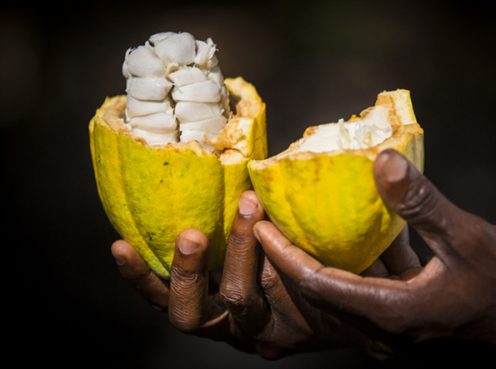The Cocoa Network
Present throughout the entire network in Ivory Coast.
COCOA: SELECTION AT ITS SOURCE
Certain chocolate makers choose to provision themselves directly in fresh or roasted cocoa beans or cocoa powder. We accompany them as they make their aromatic selection based on the country of origin or the blend of flavours so that they can create unique tastes. With our experts and our Transparence Cacao programme we can guarantee the origins of our cocoa and a consistent level of quality.
INNOVATION AND QUALITY
The success of CÉMOI lies in our standard of quality and innovation. These standards naturally led us to committing to the local cocoa producers in the main producing areas. CÉMOI masters the entire chain from bean to bar. We meet the consumers’ requirements but also those of the food industry, from the manufacturers to the chocolate professionals: chocolate-makers, pastry chefs, out-of-home caterers and the supermarket chains.
40 YEARS OF IVORY COAST

Since the 1970s CÉMOI Group has been selecting cocoa beans in the Ivory Coast, the leading global producer. In 1996 the Group decided to build a cocoa-transforming factory that now employs 340 team members in long-term contract. Today CÉMOI is positionned as one of the leading transformers in Ivory Coast. The group has built strong economical and industrial relations in the country and this local implantation has enabled us to develop the Premium Ivory Coast origin, a cocoa with exceptional aromatic qualities that can be found in our professional and finished products. Moreover, CÉMOI is the first international chocolate maker to have opened a chocolate making factory in 2015, to produce products for the West African market, made from local cocoa beans.
EXCELLENCE COCOA
Without completely generalising, it is extremely difficult to find a cocoa of irreproachable quality at an international level. The reasons are numerous, but the chocolate industry, faced with an increasing demand for dark, high cocoa-content chocolate continue looking for that perfect cocoa. The Transparence Cacao program has fixed itself the objective to commercialise premium cocoa.
Premium cocoa has zero defects, an excellent aromatic potential and respects the most demanding physicochemical and health standards. The preparation of this type of cocoa requires rigorous controls throughout the entire production process. The farmers, the farmer organisations and the technical personnel at the PACTS centres that manage the cocoa treatment, all have an important part to play in the development of this product.
The harvesting, shelling, packing and transportation of the fresh product up to the collection point are the responsibility of the farmer. Only the most mature pods are harvested, selection of the best pods is carried out immediately. During shelling, the fresh cocoa beans are sorted and the rachis, pieces of cortex and other impurities are removed. The cocoa is then bagged and identified as fresh cocoa for transport purposes, to avoid any risk of contamination. The cocoa has to be shipped to the collection point by early afternoon so that it will arrive at the fermentation and drying centre the same day. All these steps have been fully understood by the farmers who supply cocoa for this program. The collect and shipment of the fresh cocoa is carried out by the farmers’ organisations. At the collection point the bags are identified by the farmers and weighed, the quality is controlled and if the product is accepted, the farmer receives a receipt so that he can get paid that same day. When the cocoa arrives at the centre it is weighed and its quality controlled once more and everything is recorded in a log book in order to guarantee complete transparency and total traceability.
The fermentation of the cocoa is a crucial stage, allowing the aromas of the cocoa to develop. The beans are loaded into wooden cases and left for 6 days. During the first 2 days the sugary mucilage ferments to create an alcohol, after being mixed every other day an acetic fermentation takes place (transformation of alcohol into vinegar) which creates a rise in temperature.
Once the fermentation process is complete the beans must be left to dry under the sun. The cocoa is spread out in a thin layer and regularly turned. Climatic conditions permitting, 7 days later the cocoa is dry. If there is more than 3 days of rain the beans undergo an artificial, but gentle drying procedure.
There follows rigorous quality controls and bag identification for traceability purposes. The dried cocoa beans are bagged and are now ready for exportation. The cocoa that leaves our centres is perfect (zero defects) and complies with the requirements of the most demanding chocolate makers.

![[EN] CÉMOI Group](https://group.cemoi.com/wp-content/uploads/sites/7/2017/09/logo-cemoi-group.png)